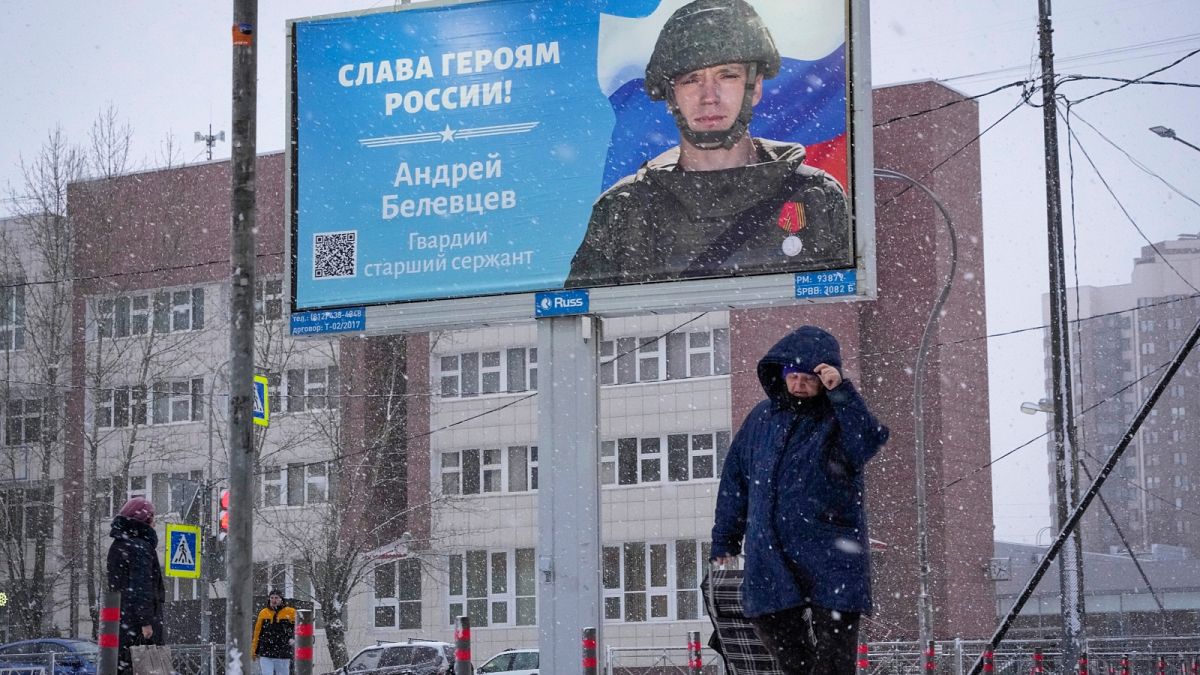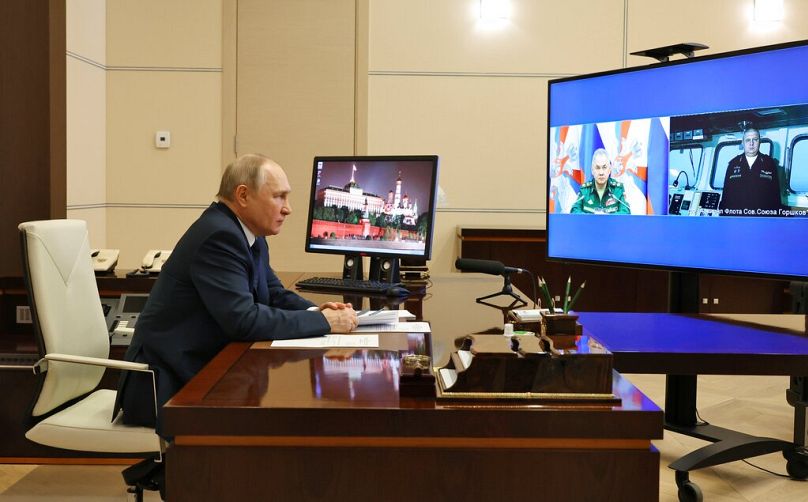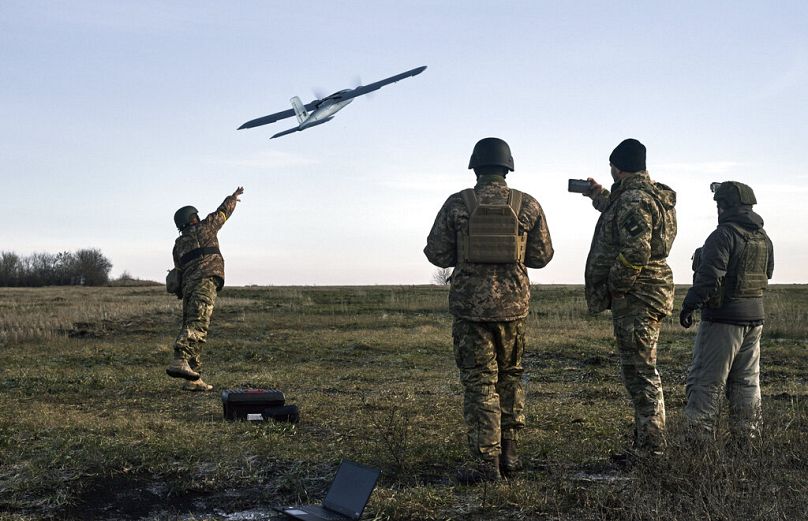Here's the latest developments following Russia's invasion of Ukraine.
1. Russia to gather more soldiers for renewed push, Zelenskyy says
Ukraine's President Volodymyr Zelenskyy said Russia was planning to call up more troops for a major new offensive, even as Moscow was facing some of its biggest internal criticism of the war over a strike that killed scores of fresh conscripts.
Kyiv has been saying for weeks that Russian President Vladimir Putin plans to order another mass conscription drive and shut his borders to prevent men from escaping the draft.
"We have no doubt that the current masters of Russia will throw everything they have left and everyone they can round up to try to turn the tide of the war and at least delay their defeat," Zelenskyy said in his nightly video address on Tuesday.
"We have to disrupt this Russian scenario. We are preparing for this. The terrorists must lose. Any attempt at their new offensive must fail."
Russia's defence ministry on Wednesday blamed mobile phone use by its soldiers for a Ukrainian strike on New Year's Eve in Makiivka in the Donbas that had killed 89 servicemen -- the deadliest incident Moscow has acknowledged for its troops since the start of the war.
If Russia is planning a new mobilisation, the deaths of scores of conscripts on New Year's Eve could undermine morale. Hundreds of thousands of men fled Russia when Putin ordered the first call-up of reservists since World War II in September after military setbacks.
Putin said last month there was no need for further mobilisation. But in a sign the Kremlin may now be considering one, a little-known group claiming to represent supposed widows of Russian soldiers released a call on Tuesday for Putin to order a large-scale mobilisation of millions of men.
The Kremlin has not commented on that appeal.
Russia has effectively shut down all direct opposition to the war, with open criticism banned by severe media rules. But it has given comparatively free rein to pro-war bloggers, some with hundreds of thousands of followers on social media.
Many are increasingly vocal about what they consider a half-hearted and incompetently led campaign.
2. Putin watches launch of new hypersonic missiles-armed frigate
Russian President Vladimir Putin attended by videoconference the mission launch of Admiral Gorshkov, a warship equipped with new hypersonic cruise missiles.
The frigate is poised to travel across the Atlantic and the Indian oceans, as well as traverse the Mediterranean, and conduct exercises with the 3M22 Tsirkon missile.
"I am sure that such powerful weapons will effectively protect Russia from external threats and help defend national interests," Putin said at the ceremony on Wednesday, which he attended with Defense Minister Sergei Shoigu from an unspecified location, according to Russian state-run agencies.
"The ship's crew will train in the deployment of hypersonic weapons and long-range cruise missiles," Shoigu said.
He pointed out that the Tsirkon hypersonic missiles were "capable of overcoming any current or future air defense system" and could perform "powerful and precise strikes at sea and on land".
Russia has suffered a series of humiliating setbacks in its full-scale offensive launched more than 10 months ago in Ukraine.
The Russian military command has faced fresh criticism in recent days after Ukrainian strikes with US HIMARS rocket launchers on New Year's Eve killed at least 89 soldiers out of hundreds gathered en masse in one building in Makiivka, a Donetsk conurbation in the Donbas.
Ukraine's General Staff also said Russian forces continued to concentrate on advancing in the area of Bakhmut, a city in Donetsk now largely reduced to ruins after months of fighting, while also trying to improve their positions elsewhere along the front line in that region.
Mikhail Razvozhayev, the Russian-installed governor of Sevastopol in Crimea, said on Wednesday on the Telegram messaging app that air defence systems had shot down two drones near the Belbek military airfield.
3. European Union's natural gas storage levels highest in six years despite Moscow cuts
Natural gas storage levels in the European Union stand at nearly 84% and were higher in December than the average amount in reserve four to six years ago, the bloc’s executive branch said Wednesday, despite Russian attempts to choke off supplies amid its war on Ukraine.
Fearing winter shortages, the 27 EU countries began stocking up on gas last year. Joint gas reserve levels climbed to 82% by September, well ahead of an 80% target set for November. Gas consumption also dropped by 20% from August to November as prices spiked.
Angered by EU war-related sanctions, Russia tightened its gas taps to Europe last year. Its pipeline gas accounted for 40% of all gas Europe imported before President Vladimir Putin ordered his troops into Ukraine in late February, but now it only accounts for around 9%.
“It’s a fairly good position to be in,” EU commission spokesman Tim McPhie told reporters. “We have a healthy level of gas storage for the start of this year, but we are by no means complacent. We know that this year will continue to be challenging.”
The commission estimates that joint gas storage levels stand at almost 84% and that storage levels in December were 13% higher than the EU average in 2016-2018. Energy prices have also tumbled in recent months, in part due to milder-than-expected winter weather.
“The more we can invest in energy efficiency, reducing energy use, and the more that we can give a boost to renewables the better we will be based in terms of reducing our dependence on gas,” which influences electricity prices and contributes to global warming, McPhie said.
The first regular shipment of liquefied natural gas from the United States arrived in Germany on Tuesday, part of wide-ranging European efforts to find new, more reliable suppliers and replace resources once bought from Russia.
4. Ukraine to ask United Nations to deploy peacekeepers at Zaporizhzhia nuclear plant
Ukraine wants the United Nations to send peacekeepers to the Zaporizhzhia nuclear power plant even without a deal with Russia to establish a safety zone there, the head of Ukraine's state nuclear power company said.
Ukraine has called for UN-led peacekeepers at the site since September. But the comment was the first time a Ukraine nuclear official has suggested publicly that peacekeepers should be deployed in the absence of an agreement to create a safety zone at the plant.
Russia took control of the Zaporizhzhia nuclear plant soon after launching the full-scale invasion of Ukraine on 24 February.
The nuclear power station, Europe's largest, has suffered repeated shelling and power cuts, raising concerns of a radioactive catastrophe. Ukraine and Russia have traded blame for the bombardment.
Rafael Grossi, head of the International Atomic Energy Agency (IAEA), had hoped to mediate an agreement between Russia and Ukraine on a safety zone by January.
Petro Kotin, the head of Ukraine's state nuclear power company Energoatom, said the absence of a deal means the UN Security Council, of which Russia is a permanent member, should deploy peacekeepers.
"The problem is there is no solution (at) the level of IAEA," Kotin told Reuters on Tuesday. "The process is not going forward. We would propose to bring this problem to the next level."
The prospects were uncertain. Russia could veto any Security Council resolution for peacekeepers. But Kotin said this would raise public awareness of Moscow's actions.
In October, Russian President Vladimir Putin issued a decree transferring the plant from Energoatom to a subsidiary of Russia's Rosatom, a move Kyiv said amounted to theft.
5. Russia and Ukraine could develop and deploy autonomous killer bots, experts say
Drone advances in Ukraine have accelerated a long-anticipated technology trend that could soon bring the world's first fully-independent fighting robots to the battlefield, inaugurating a new age of warfare.
The longer the war lasts, the more likely it becomes that drones will be used to identify, select and attack targets without help from humans, according to military analysts, combatants and artificial intelligence researchers.
That would mark a revolution in military technology as profound as the introduction of the machine gun. Ukraine already has semi-autonomous attack drones and counter-drone weapons endowed with AI.
Russia also claims to possess AI weaponry, though the claims are unproven. But there are no confirmed instances of a nation putting into combat robots that have killed entirely on their own.
Experts say it may be only a matter of time before either Russia or Ukraine deploy them -- or both.
Russia could obtain autonomous AI from Iran or elsewhere. The long-range Shahed-136 exploding drones supplied by Iran have crippled Ukrainian power plants and terrorized civilians but are not especially smart.
Iran has other drones in its evolving arsenal that it says feature AI.
Without a great deal of trouble, Ukraine could make its semi-autonomous weaponised drones fully independent in order to better survive battlefield jamming, their Western manufacturers say.
Those drones include the US-made Switchblade 600 and the Polish Warmate, which both currently require a human to choose targets over a live video feed. AI finishes the job. The drones, technically known as “loitering munitions,” can hover for minutes over a target, awaiting a clean shot.
Drones can already recognise targets such as armoured vehicles using catalogued images. But there is disagreement over whether the technology is reliable enough to ensure that the machines don't err and take the lives of non-combatants.
Fully autonomous AI is already helping to defend Ukraine. Utah-based Fortem Technologies has supplied the Ukrainian military with drone-hunting systems that combine small radars and unmanned aerial vehicles, both powered by AI.
The radars are designed to identify enemy drones, which the UAVs then disable by firing nets at them — all without human assistance.
AI is a priority for Russia. President Vladimir Putin said in 2017 that whoever dominates that technology will rule the world.
In a 21 December speech, he expressed confidence in the Russian arms industry’s ability to embed AI in war machines, stressing that “the most effective weapons systems are those that operate quickly and practically in an automatic mode.”
Russian officials already claim their Lancet drone can operate with full autonomy.
Putin predicted in a 2017 televised chat with engineering students: “When one party’s drones are destroyed by drones of another, it will have no other choice but to surrender.”


